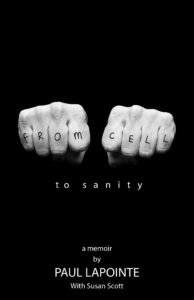There is a dark reality that has been present in the correctional facilities, and too often appears to be ignored by those in charge. The failure of the judicial system to recognize treatment over punishment has been a long-standing issue that has shattered lives, families and communities. Conflating mental illness with criminality is frequently a result of unfamiliarity with the subject at hand, and, at worst, a wilful disregard for seeking to understand the underlying problems. One man that has suffered the consequence of this is Paul Lapointe. He is the author of the memoir From Cell to Sanity, which not only stands as a testimonial regarding the failures of the correctional service of Canada, but has also sparked debate regarding solutions and possible changes for the future.
The Panel Discussion
This spring, St. Mary’s University in Calgary held a discussion panel on Corrections, Mental Health, Poverty and Social Justice, as part of their “Inspiring Conversations” series. The panel included Howard Saper (an independent adviser on Corrections Reform to the Ontario Government), Kim Pate (Canadian Senator and advocate for marginalized youth, men and women), Tim Richter (President and CEO of the Canadian Alliance to End Homelessness), and Frank Cattoni (Executive Director of SORCe – Safe Communities Opportunity and Resource Centre – a collaboration of agencies serving the homeless). The panel was designed to help spread awareness of mental health issues in the corrections system, since the first hope of change starts with education. Paul Lapointe was also in attendance at the event.
One topic that plays a major role in the lives of individuals struggling with mental health issues is the concern of homelessness—particularly, youth homelessness. Tim Richter was quick to point out that the reason for Calgary having the highest growth in homelessness is due to failures of the system in recognizing mental health. Shelters have become homes for traumatized children, but what happens to these children when the shelters are no longer able to give them the support they need? And what is it that drives some individuals to reach the conclusion that living behind a dumpster is better than going home? Questions such as these were discussed at length, and the discussion revealed that the underlining problems almost always come back to mental health.
Domestic violence is a significant source of emotional, physical, and relational impairment. Childhood abuse, neglect, and witnessing family violence has been shown to cause long lasting individual and social pathologies. Studies have disclosed that childhood abuse is one of the primary reasons for homelessness in Canada. Domestic violence can alter brain development in young children causing serious mental/personality disorders, which they carry with them into adulthood. The reason this is important to understand is because someone’s personal history will often be overlooked during a judicial hearing. The judicial system is not designed to take into account the life experiences of the offender. It does not look at the cause, but only the result. The discussion panel was put together to look at these devastating concerns and examine their source.
The Executive Director at SORCe, Staff Sgt. Frank Cattoni of the Calgary Police Service, helped launch SORCe after noticing a trend in the personal lives of the population that he and his staff were working with. Many of their clients were dealing with past traumas and in turn, began self-medicating with street drugs and alcohol. Sgt. Cattoni believes that incarceration should be a last resort for people under circumstances beyond their control, and that incarceration does not and will not cure a mental health issue. With this in mind, it is important to recognize the motives for one’s addiction, and in doing so, a program can be designed around the individual’s needs. SORCe is a collaboration of agencies serving the homeless. By bringing together multiple agencies and programs in a single location, SORCe strives to meet the unique and complex needs of each client, depending on where they are in life — and the first step to building a stronger community is to establish permanent housing for those in need so they can examine underlying issues in a safe environment.
Senator Kim Pate, formerly the Executive Director of the Canadian Association of Elizabeth Fry Societies, has been a strong advocate for women in Canada’s prison system, whose voices are seldom heard. She pointed out a major problem in the way many cases are handled – namely, that when people suffering from mental illness run up against the justice system, they are often incarcerated simply because it is the cheapest and most expedient way to clear the matter. The problem is that, in the long run, this does not remedy anything. In fact, it prolongs the issue and can often end in a catastrophic episode that cannot be undone. Sending individuals to prison because it is the easiest solution at hand is equivalent to that same person self medicating with illegal substances. It feels as though it is fixing the problem, but it is only temporary. It rarely ends well, and more often leads to an even more perilous situation.
Senator Pate also referred to the stigma attached to an individual after leaving the correctional system.
“We should not see someone with a mental illness as being “bad” just because they have been to prison,” she commented.
Time spent in prison overshadows the mental illness, causing a lifelong struggle to find employment and public assistance. The stigma could be lifted with continuing discussions and spreading awareness of the injustices that takes place in the judicial system.
Though the reality of the situation may seem grim, there is hope for the future.
Howard Saper concluded the discussion by stating, “These important debates are the first step to action.” Educating the public and standing up for those that have been wronged by the system is the first step in getting the attention that is needed to make a thoughtful change. Howard Saper, Kim Pate, Tim Richter, and Frank Cattoni are four individuals that have taken it upon themselves to actively participate in social change. They bring hope to those suffering from mental health issues, often undiagnosed, who find themselves battling life-altering events within the judicial system.
From Cell to Sanity by Paul Lapointe
 Paul Lapointe’s memoir contains a little bit of everything that was discussed on the panel, told with an authenticity that could only come with personal experience. It is an understatement to say that Paul has lived a life full of confusion, hardships, and disappointments — and facing reality became, for him, impossible.
Paul Lapointe’s memoir contains a little bit of everything that was discussed on the panel, told with an authenticity that could only come with personal experience. It is an understatement to say that Paul has lived a life full of confusion, hardships, and disappointments — and facing reality became, for him, impossible.
From an early age, Paul’s path was a difficult one to travel. Two overriding features of his early life were domestic violence and alcohol abuse. The normalization of criminal activity was set at an early age for Paul, due to his father’s involvement in bootlegging. This led to a number of interesting run-ins with the law, and with other criminals. His family’s lifestyle would prove to be an ongoing struggle and one Paul would find difficult to escape. Paul gives the reader a short history of how violence played a major role in his adolescent years. This kind of tragic family history is often a root cause for criminal activity in adults, and yet is often not recognized or addressed through the correctional system.
Paul Lapointe’s memoir is a quick-paced, chronological story of a man struggling to find a place in society, and to feel normal and accepted. He struggled with undiagnosed bi-polar disorder, often exhibiting wild behaviour, unable to control his emotions. He found himself involved with the Mafia, and cycled in and out of jail for years.
Paul’s story serves as an example of the consequences of what happens when medical services fail to recognize a mental health issue, and leave it for the courts to decide the fate of the individual. It is also a book that serves as a reminder to those that suffer, that they are not alone and that no matter how far one falls from grace, there is always a light. All one needs is that one person to listen, which in Paul’s case was a caring doctor who diagnosed and treated him for his mental health issues.

From left: Dr. Tara Hyland-Russell, Vice President Academic & Dean of St. Mary’s University; Paul LaPointe; Susan Scott, Editor of From Cell to Sanity
From Cell to Sanity opens in a negative world of addiction and crime, where one might believe hope does not venture. It ends in an expected place – a place of transformation, courage and optimism – proving that no matter how far one falls down the spiral, there is always redemption if willed, with compassion and help from others.
All photos by Sergei Belski/St. Mary’s University
Visit Paul LaPointe’s website From Cell to Sanity
If you, or someone you know, need to talk to someone about mental health in Canada (toll free):
Kids Help Phone: 1-800-668-6868
Crisis Service Canada: 1-833-456-4566











i much appreciate the article you wrote . it was very well written. thank you so much .. Paul lapointe . the author of .. from cell to sanity .